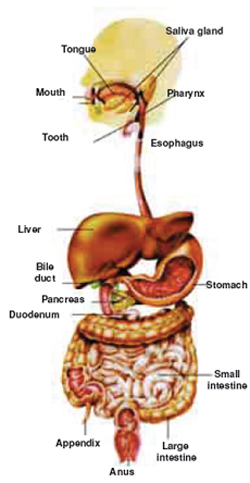We ourselves provide the substances necessary for the vital functions in our bodies to continue—in other words, for the functioning of our organs and for the renewal of our cells—from what we eat and drink. However, the meat, bread, fruit or vegetables we consume all has to undergo radical changes, in other words to be digested, in order to be broken down into substances in a form that our bodies can use.
It is the digestion of food that allows a newborn baby weighing between 2 and 3 kilograms (4.5 to 6.5 pounds) to grow into a 1.80-meter (5.9-foot) , 75 to -80 kilogram (165-to 175-pound) adult 20 to 25 years later. The source of this impressive difference in volume is the way in which substances in the food eaten by the child gradually become assimilated by the body. Some of these nutrients provide the necessary energy for living, and others are added to the body and in the form of flesh and bone. Those parts that serve no purpose are expelled from the body.
The digestive system contains the best refinery in the world. The substances taken in by this refining system are first broken down into their raw materials, then sent to be used by the necessary regions of the body. Since the materials, once broken down, are very different from one another, the new substances that emerge are also entirely different.
One can compare the workings of the digestive system to that of an oil refinery. The crude oil that enters a refinery as a raw material is subjected to a number of processes and gradually broken down, as a result of which quite different products are obtained. As the outcome of these complex processes in the refinery is produced, the gasoline that fuels your car, the basic material of the asphalt you walk on and the plastic containers you use. Similarly, very different substances emerge as a result of digestion. However, the biochemical events that take place in your stomach and intestines are far more complex than those in an oil refinery, and come about thanks to a far superior working system. In addition, these events take place not in an industrial refinery equipped with all the latest technology, but in your own body. The food you eat at breakfast is subjected to thousands of chemical processes, without you ever being aware of them while you go about your daily life, attend class in school or walk along the street.
For these chemical processes to take place, a long “conveyor belt” is needed. Special refinery systems need to be located at every point in this channel so that the materials in it can be subjected to change. The channel in question needs to be at least 8 to 10 meters (26 to 33 feet) long.
However, the human body is only an average of 1.70 to 1.80 meters (5.5 to 6 feet) in height. That means that a canal 10 meters (32.8 feet) long needs to be squeezed into a body that is five times shorter than it. This requires a very inventive industrial design. Indeed, the human body has been created with just such a characteristic. The alimentary canal in question (mouth, esophagus, stomach, small and large intestines) has been situated within the human body in line with a very special arrangement, under which a 10 meter (32.8 feet) canal has been carefully packaged into a body only 1.70 meters (5.5 feet) long.
After entering the body, consumed foodstuffs embark on a 10- meter journey through the digestive system, during which these foods are subjected to a series of mechanical and chemical processes. As they pass through the five-part, 10-meter (32.8-foot) canal, they are broken down by means of mechanical processes such as grinding, kneading and rinsing, and to chemical effects performed by liquids secreted into the canal by various glands.
Digestion has begun in the mouth and continues in the stomach and small intestine. In the small intestine, the useful substances in foods are dissolved for transportation in the blood vessels.




No comments:
Post a Comment